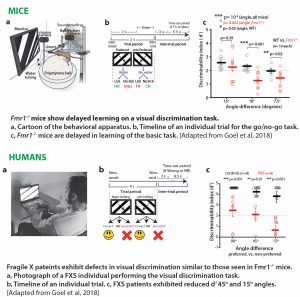Link between abnormal sensory discrimination and defects in learning and cognition in Autism
Fragile X Syndrome (FXS) is the most common inherited from of mental impairment associated with impaired language development, reduced social interactions and abnormalities in sensory processing, although how known molecular/synaptic alterations are linked to these behavioral phenotypes is unknown. This is because complex computations and, ultimately, behavior do not arise from the activity of isolated neurons or gene products but emerges from the collaborative interaction of a vast number of neurons and synapses or the neural dynamics within brain circuits.
In addition to social deficits another symptom often observed in ASD, is atypical sensory processing and this deficit can be predictive of future abnormalities in social behavior and other autistic traits, including impairments in learning and memory. For example, in the visual domain individuals with ASD exhibit abnormal visual perception and impairments in estimating the duration of visual stimuli. I have shown that hypoactivity of Parvalbumin cells and a reduction in orientation selective cells contributes to abnormal sensory discrimination and perceptual learning in mice. Strikingly, human subjects with FXS exhibit similar impairments in visual discrimination, as a mouse model of autism such as Fmr1-/- mice (Goel et.al, 2018).
Sensory discrimination is critical to many brain functions and behavior, and therefore is likely mediated by a variety of synaptic and network mechanisms. The influence of PV cells on the circuit is complex and therefore the level and duration of their engagement as well their interaction with other cell types, will change depending on the computation or behavior. We are currently examining a link between behavioral manifestations of ASD and abnormal neural dynamics associated with spatial and temporal processing.

